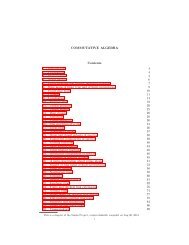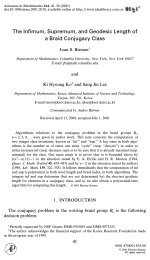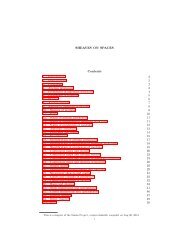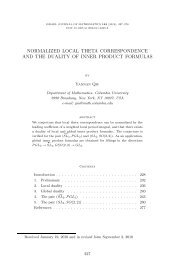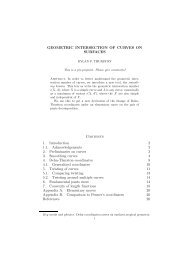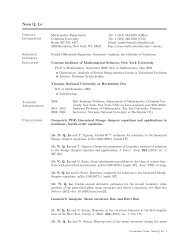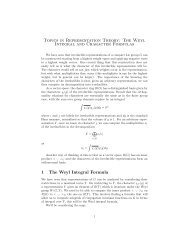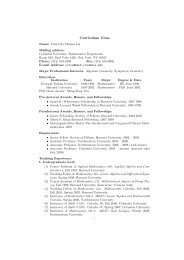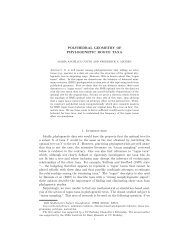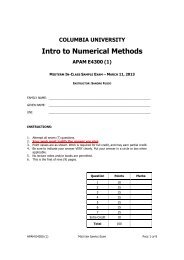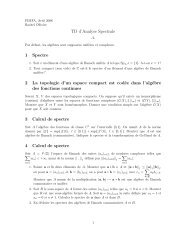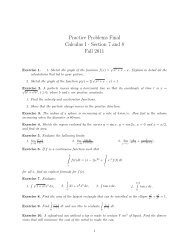INJECTIVES Contents 1. Introduction 1 2. Modules ... - Stacks Project
INJECTIVES Contents 1. Introduction 1 2. Modules ... - Stacks Project
INJECTIVES Contents 1. Introduction 1 2. Modules ... - Stacks Project
You also want an ePaper? Increase the reach of your titles
YUMPU automatically turns print PDFs into web optimized ePapers that Google loves.
<strong>INJECTIVES</strong> 21<br />
insert future reference here). However, if A is a Grothendieck abelian category, then<br />
we can use Theorem 13.6 to see that Hom D(A)(K • , L • ) = Hom K(A)(K • , I • ) where<br />
L • → I • is a quasi-isomorphism into a K-injective complex. And Hom K(A)(K • , I • )<br />
is a set.<br />
Lemma 14.4. Let A be a Grothendieck abelian category. Then<br />
(1) D(A) has both direct sums and products,<br />
(2) direct sums are obtained by taking termwise direct sums of any complexes,<br />
(3) products are obtained by taking termwise products of K-injective complexes.<br />
Proof. Let K• i , i ∈ I be a family of objects of D(A) indexed by a set I. We claim<br />
that the termwise direct sum <br />
i∈I K• i is a direct sum in D(A). Namely, let I• be<br />
a K-injective complex. Then we have<br />
HomD(A)( <br />
i∈I K• i , I • ) = HomK(A)( <br />
i∈I K• i , I • )<br />
= <br />
i∈I Hom K(A)(K • i , I • )<br />
= <br />
i∈I Hom D(A)(K • i , I • )<br />
as desired. This is sufficient since any complex can be represented by a K-injective<br />
complex by Theorem 13.6. To construct the product, choose a K-injective resolution<br />
K• i → I• i for each i. Then we claim that <br />
i∈I I• i is a product in D(A). Namely,<br />
let K• be an complex. Note that a product of K-injective complexes is K-injective<br />
(follows immediately from the definition). Thus we have<br />
HomD(A)(K • , <br />
i∈I I• i ) = HomK(A)(K • , <br />
i∈I I• i )<br />
= <br />
i∈I HomK(A)(K • , I • i )<br />
= <br />
i∈I HomD(A)(K • , I • i )<br />
which proves the result. <br />
Remark 14.5. Let R be a ring. Suppose that Mn, n ∈ Z are R-modules. Denote<br />
En = Mn[−n] ∈ D(R). We claim that E = Mn[−n] is both the direct sum and<br />
the product of the objects En in D(R). To see that it is the direct sum, take a<br />
look at the proof of Lemma 14.4. To see that it is the direct product, take injective<br />
resolutions Mn → I • n. By the proof of Lemma 14.4 we have<br />
En = I • n[−n]<br />
in D(R). Since products in ModR are exact, we see that I • n is quasi-isomorphic to<br />
E. This works more generally in D(A) where A is a Grothendieck abelian category<br />
with Ab4*.<br />
Lemma 14.6. Let F : A → B be an additive functor of abelian categories. Assume<br />
(1) A is a Grothendieck abelian category,<br />
(2) B has exact countable products, and<br />
(3) F commutes with countable products.<br />
Then RF : D(A) → D(B) commutes with derived limits.



